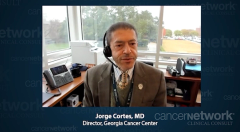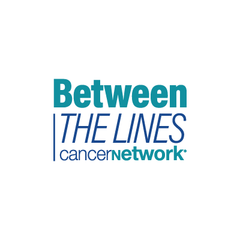
Clinical Implications of a Dose Ranging Study of Ponatinib for CML
Hematologic oncologists summarize the dose ranging study of ponatinib in patients with CML and discuss clinical implications of this work.
Episodes in this series

Transcript:
Jorge E. Cortes, MD: To summarize, this is a randomized study where patients who had received 2 or more TKIs [tyrosine kinase inhibitors], who had T315I mutation, were to receive either the starting dose of 45 mg daily, 30 mg daily, or 15 mg daily. The primary end point was achieving a transcript level of 1% or less at 12 months. Once the patients responded, they lowered the dose to 15 mg daily if they were at the 45 mg or the 30 mg. It was a dose reduction based on response. There were guidelines for dose reduction based on toxicity as well. What the results showed were that the best overall response rate for the total population was with the 45 mg daily. It was significantly higher than with the 30 mg. Then there was the subset analysis, for example, by mutations, showing the greatest benefit among the T315I mutated patients, also by the response to the prior therapy, showing that the patients that have the worst response, only complete hematologic response, did best with the 45 mg daily. It was the greater difference. Safety-wise the most important message is that there was a far lower rate of arterial occlusive events than we had seen reported with Program of All-Inclusive Care for the Elderly [PACE], with only less than 10% of patients [who] did the 45 mg having any arterial occlusive events, although a bit lower with the 30 mg daily at about 5%. Overall suggesting that 45 mg seems to get the greatest benefit, showing the safety of the drug, and this approach of starting with 45 mg and lowering to 15 mg upon response has made it into the label. What is your take as to how do you see these results, and has that made any changes in how you use ponatinib [Iclusig] in practice?
Hagop Kantarjian, MD: This is a very important paper because if we backtrack to the history of the approval of ponatinib, we now know that ponatinib is one of the most potent BCR-ABL tyrosine kinase inhibitor, and it’s the one that has the most toxicities. We worry about severe skin rashes, hypertension, pancreatitis, and those arterial occlusive events. These were the warning signs that the oncologists were made aware of, and that led to the notion that ponatinib is a drug that’s quite toxic and people were reluctant to use it. In our experience early on, we started using 30 mg daily and cutting the dose once we had a cytogenetic response. We’re doing something similar to what happened in the paper, but it was mostly a practice guideline within the institution and as an educational tool. Now we have the data that shows that ponatinib is highly effective, this is one important point. The second important point is even when you start at 45 mg daily, the toxicities are less than what was initially reported. The most important point is that there could be dose modifications that make the drug even safer. The message from this paper is that patients who need ponatinib need to start at 45 mg and then the dose is quickly reduced to 15 mg once they achieve a cytogenetic complete remission [CR]. I read the results a bit differently. If you look at 45 mg and 30 mg, you will find that outside the setting of T315I mutation, the patients with other mutations or no mutations have a good response with the 30 mg of ponatinib, and the survival at 40 years old and in figure 2B, the survival is the same. In my practice, if I have a patient with a T315I mutation, I start with 45 mg and reduce the dose quickly. If I have a patient without a T315I mutation, I’m leaning to still use 30 mg as the initial dose, and then reduce it to 15 mg once the BCR-ABL tyrosine kinase inhibitor is 1% or less. This is to reduce not only the incidence of arterial occlusive events which can be serious, but also other events such as hypertension and other.
Transcript edited for clarity.
Newsletter
Stay up to date on recent advances in the multidisciplinary approach to cancer.



















































































